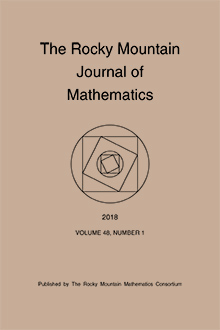Abstract
In this paper we consider the multiparameter system introduced in \cite{sch}, which corresponds to an extension of the classic minimal Daphnia-algae model. It is shown that there is a neighborhood in the parameter space where the system in the realistic quadrant has a unique equilibrium point which is a repelling weak focus of order four enclosed by a global attractor hyperbolic limit cycle. For a small enough change of the parameters in this neighborhood, bifurcation occurs from the weak focus four infinitesimal Hopf limit cycles (alternating the type of stability) such that the last bifurcated limit cycle is an attractor. Moreover, for certain values of parameters, we concluded that this applied model has five concentric limit cycles, three of them being stable hyperbolic limit cycles. This gives a positive answer to a question raised in \cite{col, Llo}.
Citation
Eduardo Sáez. Eduardo Stange. Iván Szántó. "A predator-prey system involving five limit cycles." Rocky Mountain J. Math. 44 (6) 2057 - 2073, 2014. https://doi.org/10.1216/RMJ-2014-44-6-2057
Information





